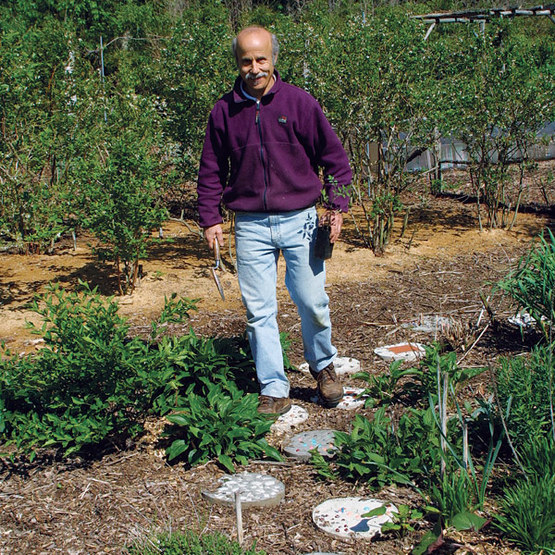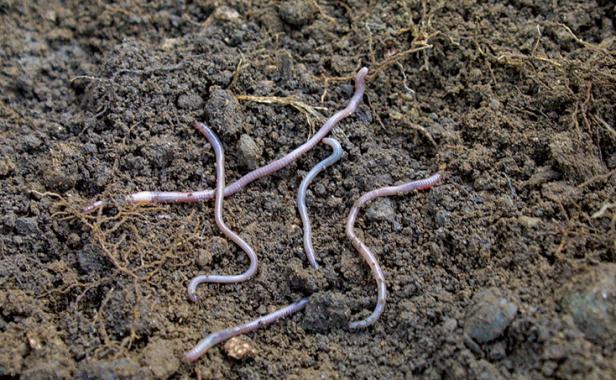Tilling Is One Chore You Might Be Able to Skip
The benefits are slim when it comes to this age-old garden practice

Turning the soil over each year is a millennium-old tradition that has been challenged only in the last half century. The major benefits attributed to the annual rite of tilling are that it aerates the soil; chops and kills weeds; and mixes in organic materials, fertilizers, and lime. Not to be downplayed are the psychological benefits of tillage. It induces a righteous-feeling sweat that makes a clean slate of last year’s mistakes. So is it any wonder that plants survive and thrive in the wild in the untilled soil of fields and forests? Not really.
The benefits are slim
One of the most common reasons people till the soil is to add air that we have squeezed out of it by tromping back and forth or rolling over it with our wheelbarrows, garden carts, and tractors. It’s true that soil needs air, but we don’t need a tiller to add it. In my vegetable and flower gardens—where I haven’t tilled the soil for more than two decades—I avoid compaction by limiting all traffic to permanently designated areas such stepping-stones among my flowers and paths around my vegetables. Each vegetable bed is only 3 feet wide so that I can reach in to plant, harvest, and weed with my feet firmly in the paths.
Another reason gardeners start up the rototiller is to get organic matter and fertilizers down into the soil where plants need them. But because most of a plant’s feeder roots lie in the surface layers, where biological activity and aeration is best, there is really no benefit to burying these materials deep within the ground. Instead, make those additions the same way nature does: by laying or sprinkling them on the surface.
Tilling is also supposed to kill weeds. This benefit, while real, is a smoke screen because, at the same time that existing weeds are killed, seeds buried within the soil are stirred awake. These weed seeds have lain dormant waiting for light and more air to awaken them, which is just what tilling the soil does—just as if weed seeds were being sown. I, along with many other gardeners, have dramatically reduced weed problems by merely abandoning tillage, an effect that studies by scientists at the U.S. Department of Agriculture have confirmed. Weeds are most easily and effectively done in by using mulches or a sharp hoe. Larger weeds, which should be few if hoeing is done regularly, are best yanked out of the soil, roots and all.
Nature can handle its own tilling
 Photo: Melissa Lucas
Photo: Melissa Lucas
Even in the untilled garden, forest, and field, you might actually say that the soil gets “tilled” to some extent. The workers here are soil-dwelling creatures, especially earthworms. Charles Darwin, whose last book was The Formation of Vegetable Mould Through the Action of Worms, With Observations on Their Habits, determined that earthworms turn over the top 6 inches of soil every 20 years. Channels left by dead roots and alternate freezing and thawing further contribute to natural soil aeration.
Doing nothing can be the best practice
Leaving the soil undisturbed has some additional benefits. For one thing, you get to plant sooner in the spring. There is no need to wait for old garden plants and weeds that were tilled into the soil to decompose. Over time, undug soils also build up a permanent system of various-size pores and channels that can move water up, down, and sideways, thus leading to more efficient water use. Churning the soil disrupts earthworms, fungi, and other soil flora and fauna, as well.
Undug soils are also better able to maintain humus, that fraction of the soil with far-reaching benefits such as improved plant nutrition, disease resistance, soil aeration, and soil water-holding capacity. Humus forms from the remains of old plants and from our additions to the soil of compost, autumn leaves, wood chips, and other organic material. But tillage usually creates a situation akin to removing money from a bank faster than it’s put in: charging a soil with so much air that humus is burned up faster than plants can use it. Adding organic materials the way nature does—by laying them on the surface—replaces or augments soil organic matter, which slowly decomposes to release plant nutrients.
Sometimes tilling is the right thing to do
There is no need, however, to make a religion out of not tilling. It might be the best way to get some air into sticky clay soil or soil at a heavily compacted construction site, for example. In these cases, a one-time mixing in of an abundance of organic matter, such as sawdust or leaves, followed by a permanent designation of traffic areas do the soil the most good. A one-time tilling is also necessary when limestone or sulfur is needed for a quick change in soil acidity; both these materials move slowly through the soil, so maintenance applications can be merely sprinkled on the surface to work down over time.
Tillage can be a viable method of soil management. If you like this method, ameliorate some of the drawbacks by not always tilling to the same depth—which creates a hardened layer called a plowpan—by adding abundant organic materials regularly and by tilling no more than is absolutely necessary.






Comments
Here is another article that has to be adapted to Texas. Here we don't have "dirt" we have clay soil. The things you want to plant in your garden DO NOT GROW wild out in the forests or prairies with this soil In some parts of our area, you can take the clay out of the ground and use it on a potters wheel and make pots. We have to till to get things down into the soil. You would never grow any under ground crop if you didn't till and mix in good stuff. In many cases it is just easier to build boxes, set in on top of the soil, and grow in them. Even with tilling, it is a challenge to grow an in ground garden. I till my garden soil at least 4 times a year, each time adding in compost, manure, peat moss, pine bark mulch, and other good items so that the soil will remain soft and allow vegetables to grow. Yes things grow naturally in this, but I dont' want to eat any of them. So when you say you don't need to till, it all depends on what you are starting with in the first place. Here it is till or build boxes,or mound new dirt on top of the old( and you need a mountain of it) or you won't have a garden. It is just a way of life in this part of Texas.
"No-till" growing started in the late 70s and 80s in the midwest, where farmers, growing hundreds of acres of silage corn, were trying to save on fuel costs and erosion. They found that application of the traditional herbicides to control weeds (mostly atrazine) was now ineffective because of the absence of yearly tilling.
Weeds are a problem, no question. You either pull 'em, use chemicals, or till... no way around it. Sure, if you have 100 sq ft, a gardener can have the luxury of experimenting with any methodology. Try mulching bittersweet, pigweed or galen saga... nope! Or just let quackgrass or crabgrass take hold (approximately 100K seeds per plant). Folks, just talk with a farmer for some sage (no pun intended) advice!
Worms are prevalent regardless of whether or not one tills, so forget that advantage. Perhaps tilling every other year could have some advantage, but very slim. All of this very scholarly and theoretical stuff looks good on paper, until one really has to produce $$ from farming. Transfer that practical approach to a family garden and success is inevitable! My $0.02 worth, after some 60 years of operating a 350 acre farm...
Tom..Are you sating to till or not to till?
I filled the beds with shredded leaves this fall. No tilling. The beds will get leaves during the fall and clippings through the summer. What I can't use goes into a compost bin.
The picture shows the 3rd bed with buckwheat as a green manure crop. Also the buckwheat is my tiller.
The beds are far enough apart to easily get my mower between them. I can use a weed eater along the edge without the danger of cutting the garden plants. I plan on re-seeding with a grass, wild flower mix to help attract bees.
I've almost never seen worms in Texas clay. Slugs, yes. Worms, no. Article is garbage. Till, baby, till.
one friends we knew when we lived in Texas, was raising worms in bins. He fed them cardboard about once a week
I am in the Midwest and I've done both to establish new garden beds. For the tilled bed what has happened over time is I have a problem with a significant number of weeds the worst being Canadian thistle and field bindweed. I've had to resort to using herbicides for control of the thistle. For the beds where I've taken a lasagna gardening approach to establishing a new bed, the weeds have been minimal in comparison. I started this bed by covering the existing lawn with a layer of paper (1/4 inch thick of newspaper, junk mail and any other paper that could be recycled), a layer of leaves and then a layer of mulch. This bed was started in the fall and by the next spring I planted by digging hole just for the plants I'd purchased. I've added shredded fall leaves as mulch each year to continue to build the soil. I never have a need to use fertilizers and except for weed grass seeds blown into the bed I typically don't have a major weed problem like the tilled bed has.
I am originally from Tennessee (red clay soils) and have also used the no-till approach and it has worked very well in clay soils as well. Weeds in new beds were minimal. Each year I'd add more leaves to the beds to enrich the soil. As I child I was told I must use a tiller to create new beds but have learned it ain't necessarily so. I'm obviously a lazy gardener so no till for me please.
There have been exceptions where I did till soil and that was when I dismantled a raised bed where I was losing the battle against field bindweed. In this instance, I gave up in herbicides & solarization and pulled out soil from bed (bind weed had strangled everything in bed by that point) and sifted out the roots and then tilled the remaining soil. After the the bed was recreated the entire bed was covered in an old wool carpet and then mulched. I left this in place for a year and then began planting. A lot of work but no more bindweed or if I see it's anemic and knocked back with a spray of herbicide.
Log in or create an account to post a comment.
Sign up Log in